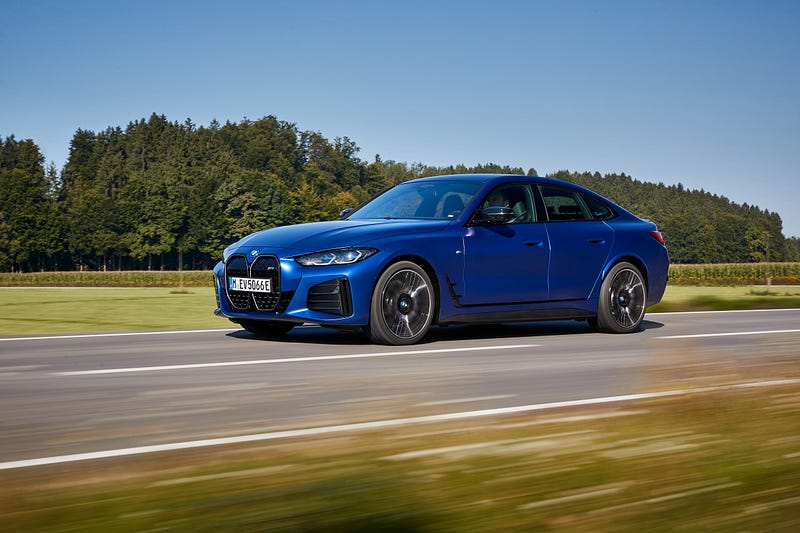The Rise of BMW's "Hand of God" System: A Game Changer for EVs
Written on
The Competitive Landscape of Performance EVs
Historically, Tesla has been the undisputed leader in the performance electric vehicle (EV) segment. While there are faster electric hypercars available, such as the Rimac Nevera or the McMurtry Speirling, their exorbitant prices often limit accessibility. Recently, numerous manufacturers have made significant strides in areas like charge times, range, and pricing, yet few can rival Tesla's impressive performance-to-cost ratio. BMW is now stepping into the fray with a revolutionary system known as the “Hand of God,” aiming to disrupt Tesla's stronghold.
To understand BMW's ambitions, we must first examine Tesla’s strengths and weaknesses. Tesla's spec sheets reveal that even its slowest model surpasses the acceleration capabilities of top combustion vehicles. For instance, the Tesla Model 3 Performance, priced at $54,000, can accelerate from 0 to 60 mph in just 3.1 seconds, outpacing the $101,000 Porsche Cayman GT4, which takes 3.9 seconds. The GT4 is often hailed as one of the top performance cars on the market today.
However, the GT4 RS can outperform the Model 3 Performance on a racetrack. The Model 3’s Laguna Seca lap time is 1:41, while the GT4 completed the same course in a blistering 1:37. What accounts for this performance gap? Despite the Model 3's all-wheel drive, its handling leaves much to be desired. Its weight and subpar suspension mean it sacrifices cornering speed for straight-line acceleration.
BMW's answer to the Model 3, the i4 M50, exhibits similar challenges. While it accelerates impressively (albeit slower than the Model 3), its cornering performance does not meet expectations. How can BMW enhance the performance of its future EVs beyond Tesla's capabilities? The answer lies in torque vectoring.
Understanding Torque Vectoring
Torque vectoring allows a vehicle to navigate corners at previously unimaginable speeds. The concept is simple: when a car turns, the inside wheel covers a shorter distance than the outside wheel, rotating at a slower pace. Differentials exist to facilitate this difference in rotation between wheels. By slowing the inside wheel and accelerating the outside one, the vehicle can be effectively "pulled" into the corner, enabling higher cornering speeds.
McLaren was one of the pioneers of this technique in 1997. Their F1 car featured a braking system that could selectively brake the inside wheels, creating a basic torque-vectoring effect. This innovation provided such a competitive advantage that it was eventually banned. Nowadays, many road cars implement automated, brake-based torque vectoring systems, which are cost-effective and reasonably efficient. Even the Tesla Model 3 Performance utilizes such a system, although it lacks the responsiveness and effectiveness of true torque vectoring.
This is where BMW's innovative system comes into play.
The Future of BMW's Torque Vectoring
Electric vehicles present a unique opportunity for precise torque and motor control. Instead of a dual-motor setup like that of the Model 3, BMW is working on a quad-motor configuration—one motor for each wheel. This allows for near-perfect torque vectoring with rapid responses, even permitting the inside wheel to rotate backward if needed. This advanced system can greatly enhance handling and significantly lower lap times.
Currently, BMW is developing the technology behind this system with prototype quad-motor EV models. Engineers have dubbed the system the “Hand of God,” reflecting the incredible force it exerts to pull the car into corners. While it will take time to fully develop, BMW intends to implement this technology in future electric iterations of the M2, M3, M4, and possibly the M5 and 7 Series. These models are expected to have even more power and potentially reduced weight, combined with the revolutionary “Hand of God” system.
Pricing and Market Impact
What can buyers expect to pay for such a high-performing vehicle? BMW executives estimate a price of around $60,000, slightly higher than the current Model 3 Performance but offering significantly enhanced performance. Tesla cannot replicate this system; the Model 3 lacks the space necessary for four motors, limiting it to a dual-motor setup and less effective brake-based torque vectoring. Even the Model S faces similar constraints, with its tri-motor configuration offering only partial advantages.
It appears that BMW is well-positioned to dominate the performance EV market. Will these advancements dethrone the Model 3 as the top choice for affordable EV performance? Only time will tell, but the future of high-speed electric vehicles is poised to become increasingly exciting.

Chapter 2: Understanding the "Hand of God" System
This video explains the functionality of the 2019 Nissan Altima's hazard warning flasher switch, providing insights into automotive safety features.
In this video, learn how to replace the front door handle on a Nissan Rogue, illustrating the hands-on maintenance aspect of vehicle ownership.